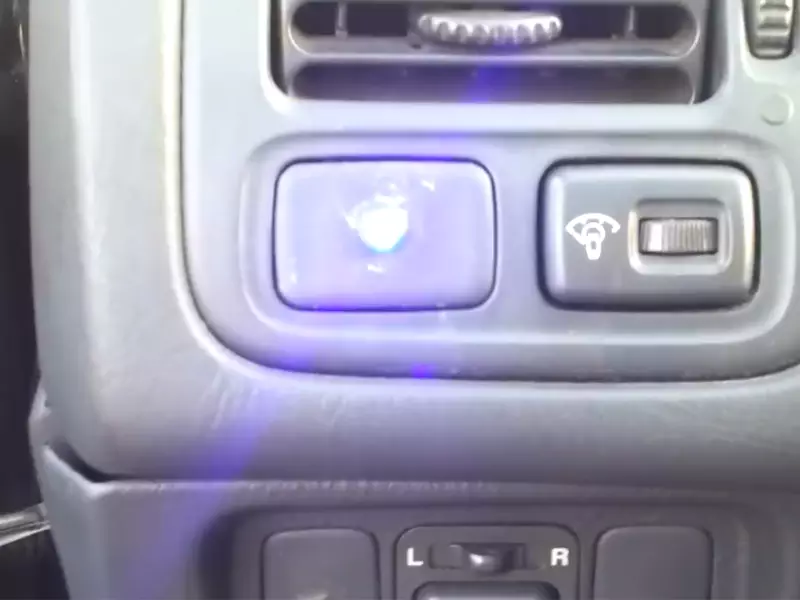To install a fake car alarm LED, first locate a suitable area on your car’s dashboard. Then, connect the LED’s positive wire to a power source and the negative wire to a ground connection.
What Is A Fake Car Alarm Led?
A fake car alarm LED is a small, blinking light that resembles a real car alarm LED. It is designed to give the appearance that your vehicle is equipped with a car alarm system, even if it doesn’t have one installed. This inexpensive and simple addition can be a deterrent to potential thieves and protect your car from break-ins. In this section, we will explore the definition of a fake car alarm LED and the purpose and benefits of installing one.
Definition of a fake car alarm LED
A fake car alarm LED is a small electronic device that mimics the look of a real car alarm LED. It typically consists of a plastic casing with a blinking light inside. The LED light flashes intermittently, creating the illusion that your car is secured with an active alarm system.

Purpose and benefits of installing a fake car alarm LED
The primary purpose of installing a fake car alarm LED is to deter potential thieves and protect your car from break-ins. By creating the appearance that your vehicle is equipped with a functioning alarm system, you can discourage criminals from attempting to target your car. Here are some of the benefits of installing a fake car alarm LED:
- Cost-effective: A fake car alarm LED is an affordable alternative to a real alarm system. It provides a sense of security without the high cost.
- Easy to install: Installing a fake car alarm LED is a straightforward process that can be done by anyone with basic DIY skills. It usually involves attaching the device to a visible location on the dashboard or near the steering wheel.
- Visual deterrent: The blinking light of a fake car alarm LED creates the perception that your car has an active alarm system. This can make potential thieves think twice before attempting to break into your vehicle.
- Peace of mind: Knowing that your car has an added layer of security can give you peace of mind, especially in areas where car thefts are common.
While a fake car alarm LED does not provide the same level of protection as a real car alarm system, it can still be a useful tool for deterring thieves. Its low cost, ease of installation, and visual deterrent make it a popular choice among car owners looking to enhance the security of their vehicles.
Gathering The Necessary Tools And Materials
When it comes to installing a fake car alarm LED, it is important to have all the necessary tools and materials on hand before you begin the installation process. Having everything prepared will make the installation go much smoother and ensure that you have everything you need to complete the job.
List of tools required for the installation
To install a fake car alarm LED, you will need the following tools:
1. Screwdriver – A screwdriver will be needed to remove any screws holding the car’s interior panels in place.
2. Wire strippers – Wire strippers are necessary to strip the insulation off the wires so that connections can be made.
3. Electrical tape – Electrical tape will be needed to insulate and secure any wires that have been connected.
4. Multimeter – A multimeter is an essential tool for checking voltage and continuity throughout the installation process.
5. Pliers – Pliers will come in handy for cutting and bending wires during the installation.
6. Wire connectors – Wire connectors are used to join wires together securely, allowing for a proper electrical connection.
7. Drill – If you need to create holes for mounting the LED, a drill will be necessary.
Required materials for installing a fake car alarm LED
In addition to the tools mentioned above, you will need the following materials for the installation:
1. Fake car alarm LED – This is the main component of the installation. The LED will mimic the appearance of a real car alarm and act as a deterrent to potential thieves.
2. Wires – You will need a sufficient amount of wire to connect the LED to the car’s electrical system. Make sure to choose wires that are the appropriate gauge for your specific installation.
3. Mounting brackets – Mounting brackets will be needed to securely attach the LED to the car’s interior.
4. Adhesive – Depending on the mounting method, you may need adhesive to ensure the LED stays in place.
5. User manual – Be sure to have the user manual or installation instructions for the fake car alarm LED on hand. This will guide you through the installation process and provide any specific information needed for your particular LED model.
By gathering all the necessary tools and materials before you start the installation, you will save yourself time and potential frustration. With everything prepared, you can proceed confidently in installing your fake car alarm LED, enhancing the security measures of your vehicle.
Step-By-Step Guide To Installing A Fake Car Alarm Led
Installing a fake car alarm LED is a simple and effective way to deter potential thieves and protect your vehicle from break-ins. While it may not provide the same level of security as a real car alarm, the presence of a blinking LED can make thieves think twice before targeting your car. In this step-by-step guide, we will walk you through the process of installing a fake car alarm LED, ensuring that your installation is both effective and discreet.
Step 1: Locating the best placement for the LED
The first step in installing a fake car alarm LED is to determine the ideal placement for the LED. The goal is to position it in a way that is visible from the exterior of the vehicle but not so obvious that it appears fake. Look for an area near the dashboard or the steering wheel that is easily visible through the windshield. This will give the impression that your car is equipped with a functioning alarm system.
Step 2: Preparing the LED for installation
Before installing the LED, it’s important to prepare it for installation. Start by removing any casing or packaging that may be present. Check the wires to ensure they are in good condition and not damaged. Once the LED is ready, you can proceed to the next step.

Step 3: Identifying the car’s wiring system
To connect the LED to your car’s wiring system, you first need to identify the appropriate wires. The best way to do this is by referring to your car’s manual or consulting a wiring diagram specific to your make and model. Locate the wires that correspond to the car’s security system, such as the ones connected to the alarm or immobilizer system.
Step 4: Connecting the LED to the car’s wiring system
Once you have identified the correct wires, it’s time to connect the LED. Strip a small section of the wire insulation, then connect the positive wire of the LED to the positive wire of the car’s security system, and the negative wire of the LED to the negative wire of the security system. Use electrical tape or wire connectors to secure the connections and prevent any loose wiring.
Step 5: Securing the LED in place
Now that the LED is connected to the car’s wiring system, it’s time to secure it in place. Use adhesive tape or a small piece of double-sided tape to secure the LED in the chosen location. Make sure the LED is positioned correctly and is clearly visible from the outside when looking into the car. Avoid placing it in a spot where it can easily be covered or obstructed.
Step 6: Testing the functionality of the fake car alarm LED
After securing the LED, it’s important to test its functionality. Lock your car and activate the security system as you normally would. Observe the LED to ensure it blinks in sync with the system. If the LED does not flash or behaves erratically, double-check that the connections are secure and the wiring is properly connected. Once you are satisfied with the LED’s functionality, you can consider your fake car alarm LED successfully installed.
By following this step-by-step guide, you can easily install a fake car alarm LED and enhance the security of your vehicle. Remember to regularly check the LED’s functionality and adjust its placement if necessary to maintain its effectiveness as a deterrent. With a little effort, you can significantly reduce the risk of theft and protect your car.
Troubleshooting Tips And Common Issues
Installing a fake car alarm LED can be a great way to deter potential thieves and make your vehicle appear more secure. However, like any installation process, you may encounter some common issues along the way. In this section, we will explore these issues and provide you with troubleshooting tips to ensure a successful installation.
Common issues faced during the installation process
During the installation of a fake car alarm LED, you may run into a few common issues that can hinder the process. These issues include:
- Poor connection: Sometimes, the LED may not light up or function properly due to a poor connection. This can be caused by loose wiring or improper installation.
- Incorrect wiring: If the LED is not working as expected, it could be due to incorrect wiring. Double-check the wiring diagram and ensure that the connections are made correctly.
- Power supply problems: If the LED fails to illuminate, it could be due to issues with the power supply. Check the battery voltage and make sure it is within the specified range.
- Defective LED: In rare cases, the LED itself may be defective. If you have ruled out all other possible causes, try replacing the LED with a new one.
Troubleshooting tips for resolving installation problems
If you encounter any installation problems with your fake car alarm LED, here are some troubleshooting tips to help you resolve them:
- Check the connections: Ensure that all the wires are properly connected and secure. Tighten any loose connections and make sure there are no frayed wires.
- Revisit the wiring diagram: Double-check the wiring diagram provided with the LED kit. Make sure you have followed the instructions correctly and all the connections are in the right place.
- Test the power supply: Use a multimeter to check the voltage of the power supply. If it is below the specified range, you may need to troubleshoot the power supply or consider replacing it.
- Replace the LED: If the LED is not working despite all other troubleshooting attempts, try replacing it with a new one. Ensure that the replacement LED is compatible with your specific alarm model.
By following these troubleshooting tips, you can overcome common installation issues and ensure that your fake car alarm LED is installed correctly, allowing you to enhance the security of your vehicle.

Additional Tips And Recommendations
If you have decided to install a fake car alarm LED to enhance the security of your vehicle, there are a few additional tips and recommendations that can help you optimize its effectiveness and maintain its longevity. Following these guidelines will ensure that your fake car alarm LED acts as a deterrent against potential thieves and remains in good working condition for an extended period of time.
Tips for optimizing the effectiveness of a fake car alarm LED
When it comes to maximizing the deterrence factor of your fake car alarm LED, here are some useful tips to keep in mind:
- Install the LED in a prominent location: To effectively simulate the presence of a genuine car alarm, it is important to install the LED in a highly visible location. Place it near the dashboard or on the center console where potential thieves cannot miss it.
- Ensure proper wiring and connections: To make the LED more realistic, it is essential to connect it to your car’s electrical system in a way that it blinks at the same rate as a genuine car alarm LED. Follow the manufacturer’s instructions carefully and check the wiring periodically to prevent any loose connections.
- Use a tamper-proof LED design: Invest in a fake car alarm LED that has a tamper-proof design. This will make it difficult for thieves to remove or disable the LED, further enhancing its effectiveness as a deterrent.
- Pair it with other security measures: While a fake car alarm LED can be a valuable deterrent, it is always recommended to use it in conjunction with other security measures. This can include installing an actual car alarm system, using steering wheel locks, and parking in well-lit areas.
Recommendations for maintaining the LED’s longevity
Maintaining the longevity of your fake car alarm LED is crucial to ensure its ongoing effectiveness. Here are some recommendations to help you maintain the LED:
- Regularly inspect the LED: Take the time to regularly inspect the LED to ensure that there are no signs of damage or wear. If any issues are detected, such as a cracked casing or dimming lights, consider replacing the LED to keep up the illusion of a functional car alarm.
- Protect the LED from harsh weather conditions: Excessive exposure to rain, snow, or extreme temperatures can result in premature wear and tear of the LED. To prevent this, consider adding a protective cover or housing to shield the LED from the elements.
- Clean the LED surface: Over time, dust, dirt, and grime can accumulate on the surface of the LED, making it less visible and realistic. Regularly clean the LED using a soft cloth and mild soap to maintain its effectiveness.
- Ensure proper power supply: Fake car alarm LEDs are usually connected to a power source through the car’s electrical system. It is important to ensure that the power supply is stable and that the LED receives the proper voltage to function optimally. Check the power connection periodically to avoid any issues.
By following these tips and recommendations, you can optimize the effectiveness of your fake car alarm LED and ensure its longevity, providing you with an added layer of security and peace of mind for your vehicle.
Frequently Asked Questions For How To Install A Fake Car Alarm Led
Can You Install A Car Alarm Yourself?
Yes, you can install a car alarm yourself. It is a straightforward process that can be done with basic tools and a little patience. Following the instructions provided with the alarm system will help ensure a successful installation.
How Do You Install A Car Theft Alarm?
To install a car theft alarm, follow these steps:
- Choose a suitable alarm system for your vehicle.
- Locate the necessary components, such as the control module and sensors.
- Follow the manufacturer’s instructions for wiring and mounting the alarm.
- Test the alarm system to ensure proper functioning.
- Securely install the alarm components to prevent tampering or theft.
Do Car Alarms Have Lights?
Yes, car alarms often have lights. The lights are designed to deter potential thieves by attracting attention to the alarm system. They can flash or stay on continuously, depending on the specific car alarm model.
Can I Install A Fake Car Alarm Led Myself?
Yes, you can easily install a fake car alarm LED yourself. All you need to do is find a suitable location, usually near the dashboard, and connect the LED to the car’s electrical system. It’s a simple and effective deterrent that can fool potential thieves into thinking your car is protected.
Conclusion
Installing a fake car alarm LED is a simple and effective way to enhance the security of your vehicle. By following the step-by-step instructions provided in this blog post, you can easily complete this DIY project. Remember to choose a strategic location for the LED and ensure that it is visible to potential thieves.
With this added visual deterrent, you can enjoy peace of mind knowing that your vehicle is protected. Stay safe and secure!
